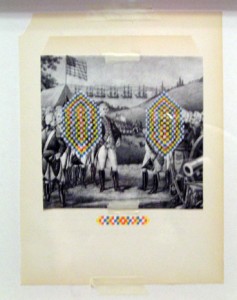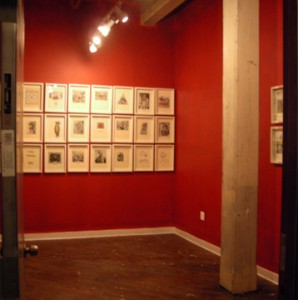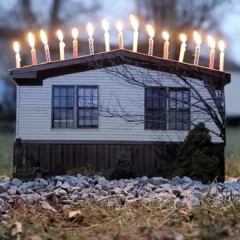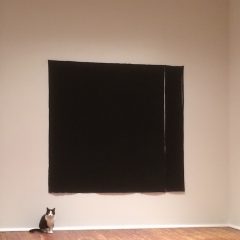Since American history is a required subject in high school, most of us are at least vaguely familiar with the narrative told in standard American history textbooks. We would probably also recognize the iconic images of battles, generals, and presidents used to illustrate this narrative. In his show “Future Myths” at Grizzly Grizzly, Matthew Craven has appropriated these textbook images to form collages that question, rather than confirm, the patterns we were taught to see in American history.

What better way to symbolically deconstruct the traditional narrative of American history, than to literally cut apart history textbook images and rearrange them? On top of the historic black-and-white reproductions, Craven has superimposed colorful geometric designs of circles and triangles. The background of one untitled collage, for instance, shows soldiers from two armies facing each other. The upper body of a soldier from each group has been replaced by a hexagon made up of smaller squares. These multi-colored hexagons are far more prominent than the pattern on the American flag held by one army, suggesting that the two groups of soldiers have more in common than we would imagine. More generally, the presence of abstract, modernist designs in the middle of old images hints at the potential to find new patterns in old stories.
Craven’s techniques also refer to a purposely jarring mixture of time periods. The historic images were originally painted in oils or captured by early cameras, but were later digitally reproduced in mass to make their appearance in the textbooks in which Craven found them. Craven’s own additions to the collages also embody a juxtaposition of techniques from different eras. Although his geometric shapes are delineated in printer ink—suggesting the convenience of modern-day technology—they are in fact hand-drawn. Craven directed my attention to the sometimes uneven outline of the shapes, and visible edges of the different collage layers; he deliberately avoids the streamlined appearance so easily achieved with contemporary tools like Photoshop. By blending techniques from different time periods, Craven questions the idea of a straightforward timeline or narrative.
Craven also keeps the theme of unexpected narrative in mind when considering the overall impression made by the show. From the gallery’s entrance, I could see only an arrangement of collages hung in straight rows and columns on the back wall. The contrast of the mostly white collages against the red of the walls (painted especially for the show) kept my eyes focused on this part of the room. It was a few minutes before I realized that there were two more collages hidden behind a column on another wall.

“History is Written by the Winners” is the name of Craven’s 2009 show. In “Future Myths,” Craven clearly demonstrates that a different narrative would emerge if history were told by the losers. But what exactly would that narrative be? Some of Craven’s pieces, such as the untitled collage of two armies, seem to lend themselves easily to analysis. Others, however, such as an image of a intricate tile from a Midwestern church, resist interpretation. I wondered why certain collages were hung next to others. Was the entire show meant to form a new narrative of the American past?
When I asked Craven to elaborate, I was surprised when he explained that many of his creative decisions are simply based on aesthetics. His work process involves experimenting with different arrangements; “If it works,” he told me, “I keep it. If not, I try something else.” As such, his collages don’t offer a new reading of history as much as they suggest that less conventional patterns do exist. Viewers who are already familiar with this idea might be disappointed that while Craven successfully deconstructs one narration, he falls short of constructing a new one. Still, aesthetics are in a sense relevant to the theme of Craven’s show. After all, why did the winners write history in the way they did, if not to make themselves “look good?” If aesthetics form the basis of our idealized narratives of the past, it is only fair that they play a role in determining Craven’s “Future Myths.”









